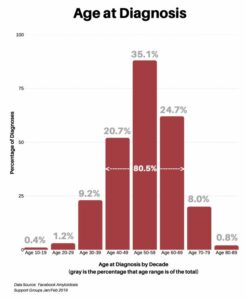Is the age at diagnosis of AL Amyloidosis changing?
According to a paper published in 1995 based on a study of 474 AL Amyloidosis patients, the median age of diagnosis for patients was 64 years.1 Being curious as to whether this number has been lowering since then, we went to the Amyloidosis patient community to conduct an informal survey in early 2019.
We heard from 251 wonderful patients from the Facebook Amyloidosis Support Group in response to our question as to how old they were when they received their diagnosis.
Here is what we learned.

- 80% of patients were diagnosed between the ages of 40-69.
- The largest group at 35% of patients surveyed, were diagnosed in their fifties.
- The second largest group, at 24% of patients surveyed, were diagnosed in their sixties.
- The third largest group, at 20% of patients surveyed, were diagnosed in their forties.
- Just over 10% of patients were diagnosed before the age of 40.
- The smallest group, at just over 8% of patients surveyed, were diagnosed over the age of 70.
We then organized the data by age to determine the occurrence rate by age range.
In answer to our question about the age at time of diagnosis, per our informal online survey of 251 AL Amyloid patients, the data indicated a mean (or average) age of 54.8 years and a median age of 56. The “mean” is the “average,” where you add up all the numbers and then divide by the number of numbers. The “median” is the “middle” value in the list of numbers. While not possible to definitively conclude, we acknowledge there may some age bias in our results towards younger ages due to the source being social media, and inaccuracies due to data being self-reported.
During the course of our research, we discovered other patient studies which we found informative. In 2015, an AL Amyloidosis patient experience survey was conducted online with 533 respondents.2 Their results indicated a median age at diagnosis of 57. A more recent study in 2017 of 341 AL Amyloidosis patients from across the U.S. found the average age to be 60 years.3
We also posed the question “Do you think the median age upon diagnosis is lowering?” to doctors at some of the leading Amyloidosis centers in North America. Each of these doctors confirmed that the median is in the range of 57-65. However, one noted that “they are seeing far too many women in their 30’s and 40’s” in clinic. Another noted that they do seem to have an increase of younger patients, pointing out that this may indicate that the disease is being diagnosed in its earlier stages.
While ours was an informal online survey, the results are interesting and worth watching going forward. But we can all agree that this is what we want – that over time the age at diagnosis will lower. Not because the disease is spreading to a younger generation, but because it is being diagnosed in its earlier stages.
It is common for many Amyloid patients to suffer for years before they receive their diagnosis, delaying treatment while the disease progresses. If we can continue to spread awareness of the early warning signs to ensure that doctors across a multitude of disciplines have the latest information and diagnostic tools, hopefully, Amyloidosis will increasingly be diagnosed in its earlier stages. By doing so, treatment can begin sooner and, we believe, better patient outcomes can be achieved.
Mackenzie
A big shout out to Lori Grover for her collaboration on this piece. Lori is a guest blogger for Mackenzie’s Mission. She was diagnosed with AL Amyloidosis in 2016 and writes to share experiences and lessons learned during her journey. More wonderful blogs by Lori can be found on her page Amyloid Assassin. When not writing, she is mostly a stay at home mom, florist, crafter, lover of books and food.
(1) Kyle RA, Gertz MA. Primary systemic amyloidosis: clinical and laboratory features in 474 cases. Semin Hematol. 1995;32:45–59. [PubMed]
(2) Lousada I, Comenzo RL, Landau H, Guthrie S, Merlini G. Light Chain Amyloidosis: Patient Experience Survey from the Amyloidosis Research Consortium. Advances in Therapy. 2015;32(10):920-928. doi:10.1007/s12325-015-0250-0.
(3) McCausland KL, White MK, Guthrie SD, et al. Light Chain (AL) Amyloidosis: The Journey to Diagnosis. Patient. 2017;11(2):207-216.